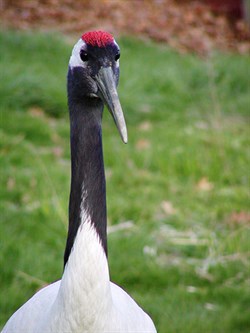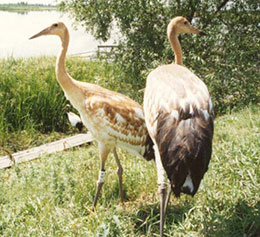Conservation takes flight: Zoo New England’s red-crowned crane spotted in Russia
Wednesday November 4, 2015
 A red-crowned crane, hatched from an egg laid at Franklin Park Zoo 19 years ago, was recently spotted with its presumptive mate in Russia’s Muraviovka Park. This sighting marks a soaring success towards the survival of this endangered species.
A red-crowned crane, hatched from an egg laid at Franklin Park Zoo 19 years ago, was recently spotted with its presumptive mate in Russia’s Muraviovka Park. This sighting marks a soaring success towards the survival of this endangered species.
This bird’s journey to Russia began in 1996 as part of Zoo New England’s participation in the red-crowned crane Species Survival Program. For the first leg of their travels, fertilized eggs produced from red-crowned cranes at Franklin Park Zoo were transported to the National Aviary in Pittsburgh, PA, which coordinated all egg transfers to Russia. Through the transfer program, eggs hatched in captivity were reared and released to augment the wild population.
Along with other red-crowned and white-naped crane eggs from a number of participating AZA zoos nationwide, unhatched eggs were transported to the Khingansky Nature Reserve in Far East Russia.
Known as the "crane" nature reserve, Khingansky’s mission is to conserve extremely endangered cranes and storks in their natural wetland habitat along the Amur River Basin. Researchers at the reserve discovered that wild cranes that pair with cranes reared in captivity become more accustomed to humans. As a result, these birds are less likely to abandon their clutches when humans are near, leading to a gradual increase in local crane populations.

Red-crowned cranes at the Russian hatch site.
Red-crowned cranes are one of the rarest of the 15 crane species. According to IUCN’s Red List of Threatened Species, there are less than 3,000 of these endangered birds left in the global population. The chief threat to their existence is the degradation and loss of their breeding wetlands and wintering grounds due to agriculture and industrial development.
Though the egg transfer program concluded in 2005, visitors to Franklin Park Zoo can still see the red-crowned crane, now 33 years old, who fathered the wild offspring who has flown free for the past 18 years.
Learn more about:
- Red-crowned cranes
- Zoo New England's conservation work locally and abroad

